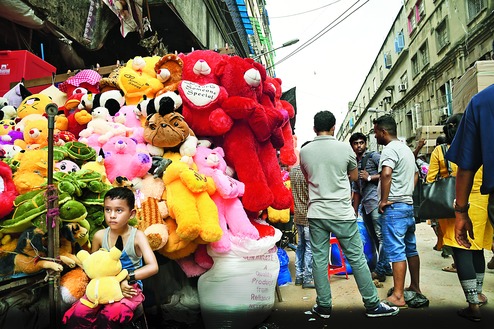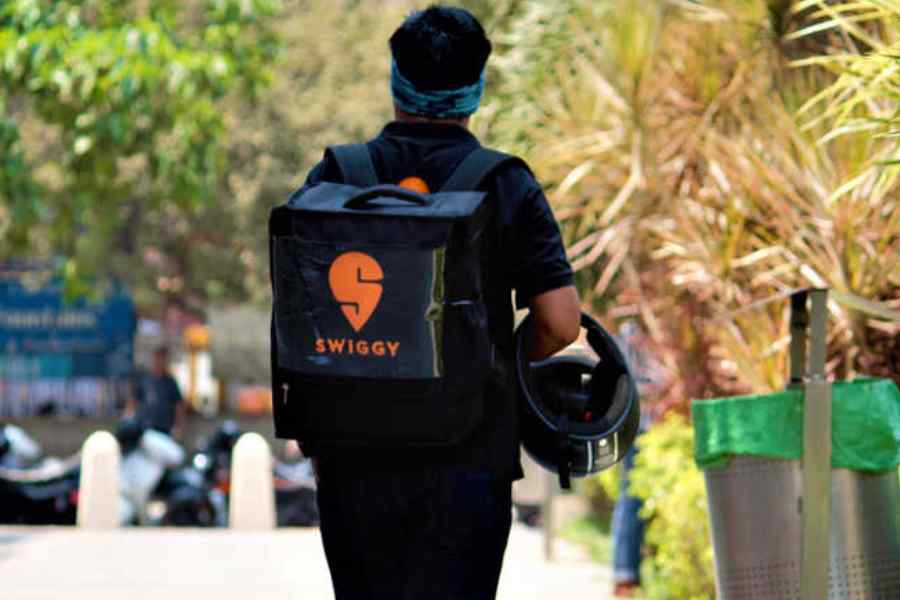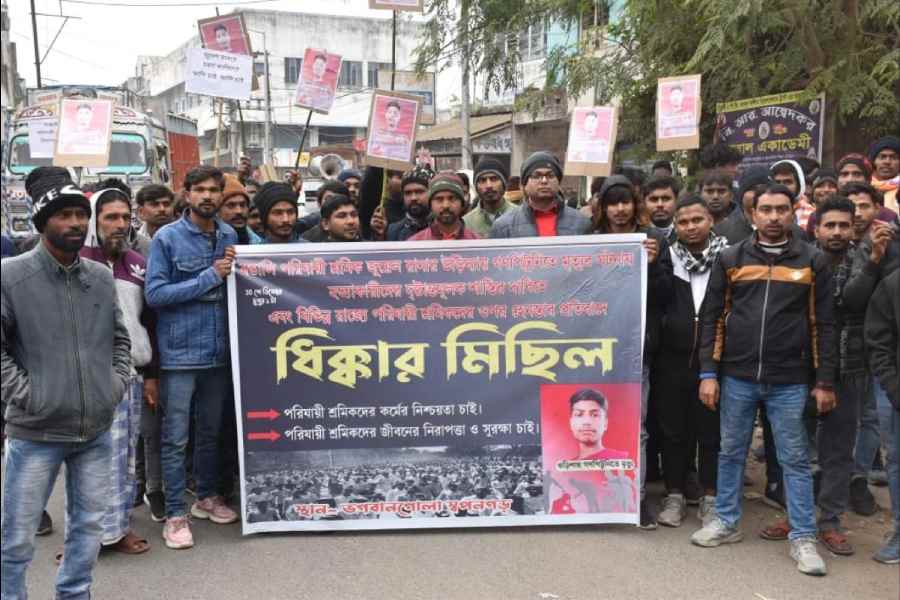
At first you think you have died and gone to bargain heaven. And then you come around and realise you are not the only one pinching yourself. We are at central Calcutta's Bagri Market in the Burrabazar area. On either side of the road and outside the regular establishments, there are makeshift stalls selling all kinds of things - wallets that look like the post DeMo 2,000 and 500 rupee notes, hair clips, ear buds, dolphin key rings, packs of balloons, rubber bands, hangers, torches, lanterns, mini table fans, rubber place mats resembling crochet work... Dus rupaiya, dus rupaiya, dus rupaiya - that's the practised chant around this place. The style of delivery is worth the study - moving from loud and slow, to loud and fast, to a siren drone. The effect is hypnotic. You can see even the locals, the regulars of the area, getting sucked into it unwittingly. Not everything is actually for ten rupees, but it comes cheap enough. Diwali is only days away and most opportunely there are heaps of rangoli stickers, battery-operated diyas and plastic torans or auspicious door hangings. Each and every item has been made in China.
At this point, you are most likely shaking your head from side to side, but smiling, thinking -"That's why I prefer to pick up everything I need at the mall. Wherever on earth is this Bagri?" That's the thing - Bagri is everywhere.
India might continue to fret and fume over Chinese incursions in Doklam and Demchok, lock horns with the neighbour and follow it all up with self-congratulatory talk about "peaceful resolution", but truth is, China has made deep inroads into Indian economy and the Indian way of life. India's imports from China in 2016-17 stood at US $61.28 billion - it was US $1.5 billion in 2000-01. And none of this happened overnight.
In the 1970s, Madan Saraff was supplying, among other things, carpet material to buyers outside India. At the time, Calcutta's jute mills were beset with trade unionism - strikes were routine and production heavily interrupted. Says Saraff, "One such strike took me to China. My buyer in the US would be in trouble if a consignment of jute carpet backing cloth did not reach on time." On the advice of a friend, Saraff went to Hong Kong, where another friend arranged for him to meet a jute factory owner based somewhere near China's Canton province. The friend arranged for an interpreter and also got the requisite permissions in place.

Saraff remembers how his Chinese business hosts kept their promise of timely shipment of desired quality. He also recalls his surprise when people would come up to him and want to touch him on the arm. "Later, I learnt the Chinese had never seen a human being with hair on the arms," he guffaws. Touched thus, Saraff continued to do business with China for the next three decades.
Saraff had discovered China in 1978, which was when China launched a series of reforms - beginning with the agricultural sector - that heralded its manufacturing revolution.
In the late 1980s, when Pritimoy Chakraborty started doing business with China, he found a country that was way ahead of the one Saraff had done business with. In their 2014 paper "China's Manufacturing Success: Lessons for India", writing about the transformation, authors Pravakar Sahoo and Abhirup Bhunia observe that privatisation had begun to gather steam in China around this time.
China's exports grew, as did India's - but with a difference. Sahoo and Bhunia point out that China took one step at a time, moved from being based on primary goods to being focused on industrial development, urbanisation, growth in manufacturing and finally knowledge-based services. A lot of power was granted to the provinces and between 1979 and 1991, 2,483 production-enabling laws were passed by the provincial governments. India, on the other hand, neglected its manufacturing sector, and its policies were not enough to propel industrial development.
Chakraborty's company, Zenith Finesse India Pvt. Ltd, imported corporate gift items from China for companies such as ITC, Nestle and HLL. Later, he graduated to importing electronic items. When asked about the common allegation that Chinese goods tend to be of poor quality, the otherwise charming Chakraborty turns all aggressive. "I blame Indian traders who think it is very clever to drive a hard bargain and pick up sub-standard goods. The Chinese have something for everyone, it is up to the purchaser to make an informed choice," he says, pointing to the 20-year-old Zenith AC purring in his office room.
Chakraborty, who wound up his business in 2007, is nostalgic. He names one unpronounceable Chinese province after another and how each of them specialised in manufacturing a particular genre of product - furniture, electronics... This ties in with what Sahoo and Bhunia say about special economic zones or SEZs in China's coastal cities and provinces and how they contributed to the country's economic growth.
The paper says how the rules governing these SEZs were made favourable to foreign investment and money began to flow in. In contrast, India announced a policy to encourage SEZs in 2000, but it didn't attract foreign investors for reasons ranging from political disagreement to lack of infrastructure support to legislative complexities.
That phones and LEDs and a lot of other consumer durables widely used in India come from China one is aware of, but what are the other imports that have permeated our environs?
Anurag Kandoi imports flex banners, used to make signages and hoardings. He has been doing so for the last 15 years. When he started, there were no manufacturers in India. Now there are, but Kandoi isn't planning to go swadeshi. Reason: doing business with China is far easier. "Say, I want to export pressure cookers. I get my principal product and the ancillary ones in the same place. I don't have to go running around for packing box, polythene, etc. in China."
Deepak Mehta has a shop on Lenin Sarani in Chandni market, yet another hub of China-made products. He deals in plastics and wallpapers. He tells us there is no wallpaper manufacturer in India. "The choices are China, Korea and Germany. We prefer China; the others are very expensive. In general, China can afford its manufacturing costs because production is huge. After all, it is exporting to the whole world while we manufacture only for domestic use." When it comes to plastics, for a lot of the products, Mehta says there are manufacturers in India, but neither is the quality good, nor are the rates.
A little ahead of Chandni is New Market. Skirting the main market are rows of unbranded soft toys, handbags and luggage items. These are also from China. "Some factory rejects, some fakes, a lot of it smuggled," says a vendor, who doesn't want to be named.
Anil Somani, who owns a home décor shop in Siliguri, talks about how the city in north Bengal is a gateway for smuggled Chinese goods into India. "They come via Burma, Nathula, Nepal..."
Ashwani Mahajan, the national convener of the Swadeshi Jagran Manch (SJM) - the "nationalist" economic front of the RSS - confirms that illegal imports and under-invoicing of Chinese goods is rampant. "It is believed to be equivalent to India's total manufacturing output. Jitna hum banate hain, utna hi hum import karte hain."
A lot of the branded consumer goods we use in our day-to-day life are also from China. Amartya Shaw, who runs a cosmetics shop in New Market, tells The Telegraph that several well-known global brands - even those headquartered in the US and UK - have outsourced their manufacturing to China. "Make-up accessories such as beauty blenders, pencil sharpeners, manicure and pedicure kits are from China," he says, as he points to the fine print on a product box.
Shuvomoy Bose has been doing business with China since 2003. He currently represents a Chinese company in India that is into equipment supplies for the steel industry. He talks about how China used its vast population to its advantage, grabbed markets that countries like Japan and Germany ignored, and the advanced technology that made it all possible.
Suresh Chandra Shah has experienced the crippling effect of this tech lag. Shah owns a firm that has been selling diesel engine parts for the past 50 years. Earlier, he used to sell six to seven tempos laden with goods in a month; now, he barely manages to fill one. "China has killed our industry," he says.
Sahoo and Bhunia explain how China's tech prowess is linked to its foreign direct investment (FDI) inflow. In India, as they point out, the lack of FDI has meant that technology transfers of consequence have hardly taken place. Says Shah, "Those who import, even after paying duty, make a profit. And if I want the same technology, I have to purchase new machines. First, how can I afford that? Second, what will I do with the old machines? Even if I sell them, I will get nothing in return." He adds that hubs for diesel engine parts in Rajkot, Punjab and Ludhiana collapsed for this reason.
SJM's Mahajan explains the impact of dumping - wherein a country sells its pro-ducts at a lesser price in another country - on the pharmaceutical industry. It seems there was a time when India used to produce all active pharmaceutical ingredients or drug ingredients for its pharma sector. "But now we are dependent on China to the tune of 80 per cent. And now they have doubled the price of amoxicillin (an antibiotic) and made folic acid 11 times costlier. How will our pharma industry survive?"
Mahajan reminds us that the BJP government has imposed anti-dumping duty on 90-plus products of Chinese origin and 40 more are to be added to the list. Previous governments were not as aggressive about invoking this measure, he does not let you forget. He adds, "Not just national security, we have to look out for our job security, the economy and employment security of our people. Our capabilities have been reduced, they need to be revived."
It might not be as simplistic, but it actually is. China probably needs not to be countered so much in Doklam as in Bagri.










